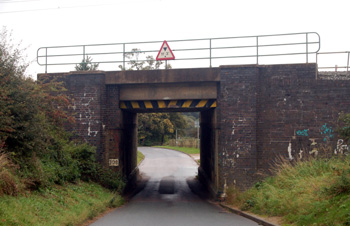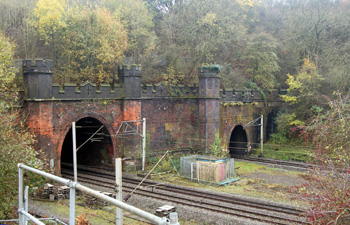
Old Linslade Road railway bridge, October 2008
What is today known as the West Coast Main Line was originally built by a number of companies. The southernmost section, running from London's Euston Station to Birmingham's Curzon Street Station was built by the London and Birmingham Railway, whose engineer was Robert Stephenson, son of George Stephenson, the two men largely responsible for designing and building the locomotive Rocket.
This railway line ran through Linslade and had a station there called, somewhat confusingly Leighton Buzzard station. Until 1965, when Linslade was transferred from Buckinghamshire to Bedfordshire, forming part of the new civil parish of Linslade, no part of this railway ran through Bedfordshire. The Act of Parliament allowing the purchase of the necessary land was passed in 1833 and the line was opened on 17th September 1838.

Linslade Tunnel north entrance, November 2008
The north entrance to Linslade Tunnel was listed by the former Department of Environment as Grade II, of special interest. The Department's description is as follows: "Red brick castellated retaining wall with 3 horseshoe arches in moulded surrounds, central arch taller, 3 semi-octagonal embattled turrets. An interesting example of early railway architecture". The south entrance to the tunnel, which is very similar, is also listed.
In 1846 the London and Birmingham Railway merged with the Grand Junction Railway (which ran from Birmingham, Curzon Street to Newton Junction near Warrington [Cheshire]) and a few other companies to form the London and North Western Railway. This, in turn, was absorbed by the London, Midland and Scottish Railway in 1922 and in 1948 all railways were merged into the nationalised British Rail. The line through Linslade was electrified in the 1960s. In 1994 British Rail was broken up and privatised with all the tracks being managed by a private company called, listed on the Stock Exchange, called Railtrack. Following a number of high profile train crashes the company was sold to a new "not-for-profit" company called Network Rail in 2002.
Fred Cockman, in his book The Railway Age in Bedfordshire gives examples of timetables including one for July 1850 showing that an express train leaving Euston should arrive at Leighton Buzzard, the first stop, one hour later, whereas other trains took an hour and a half between the two points.